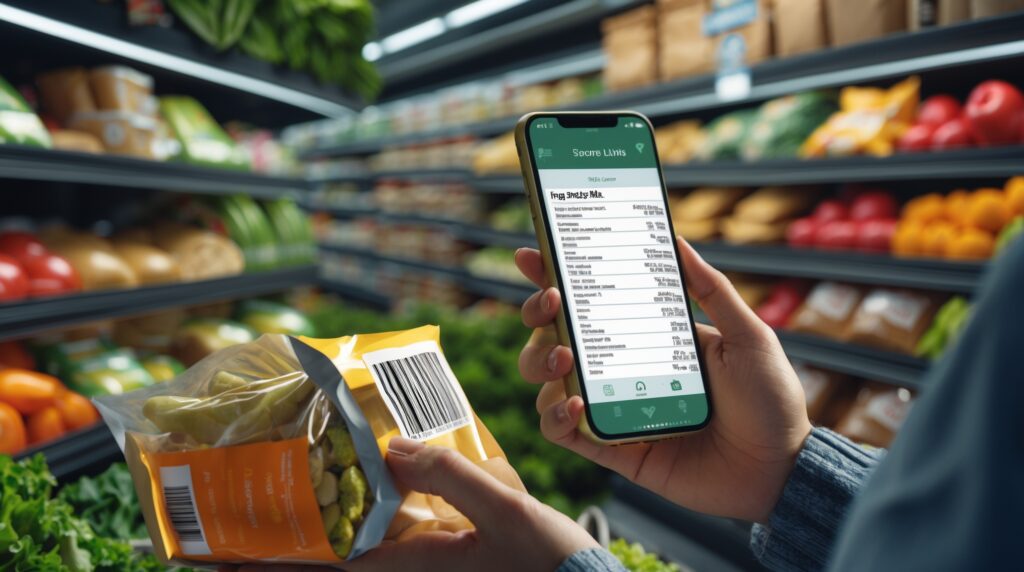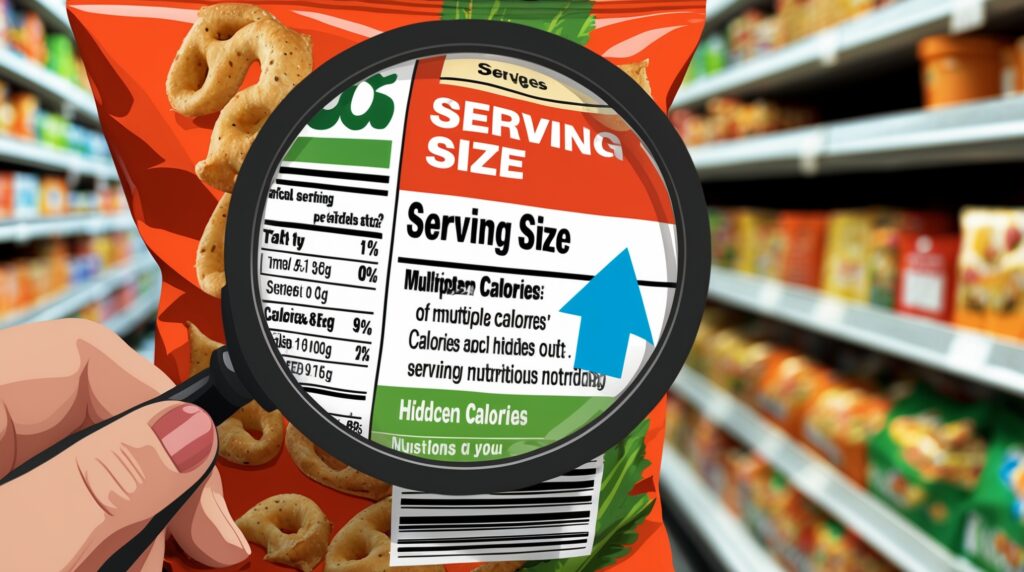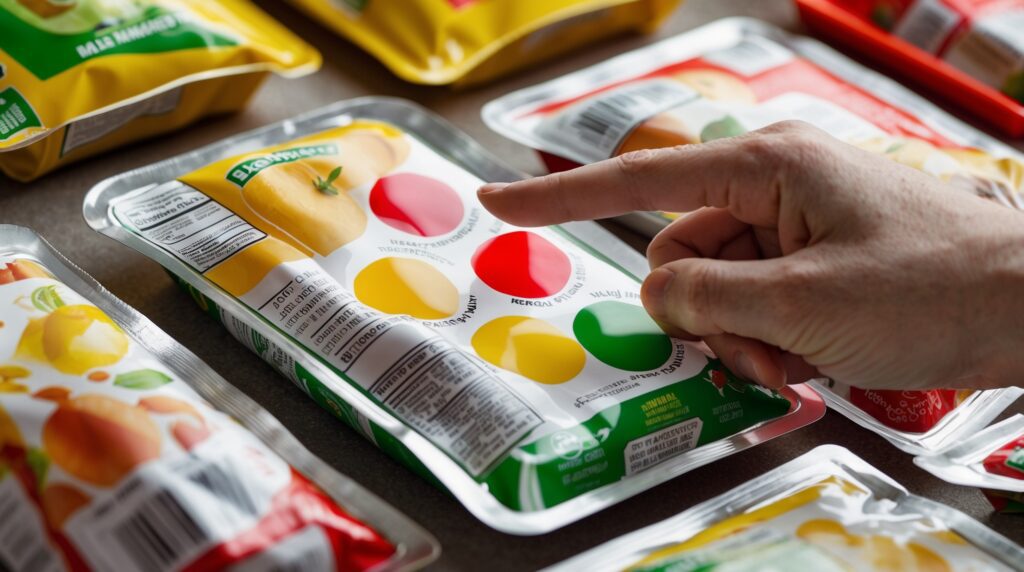Ever grabbed a “healthy” snack off the shelf, only to check the ingredients later and find it’s packed with sugars and fake additives? Yeah, it happens frequently with almost everyone. Those big bold claims on the front of the package are great at catching your eye – not so great at telling what is inside.
I get it, flipping a package over to squint at tiny print feels like homework. But once you learn how to read food labels and know what to look for and what to avoid, you’ll spot the imposters right away. Think of it like learning a secret code — one that helps you make better choices without falling for marketing tricks.
Those little panels on the food packages are actually packed with useful information if you know how to read food labels the right way. Between sneaky serving sizes, confusing ingredients lists, and all those numbers, it is easy to feel lost. But here is the thing: with diet-related health issues on the rise, taking a few seconds to check labels can make a real difference.
Funny enough, studies show that people who make how to read food labels a habit tend to eat better and stay healthier. It’s like having a cheat sheet for making smarter food choices once you get the hang of it. You’d be surprised how often packaging hides unhealthy ingredients — as explained in our guide on 5 Sneaky Food Label Tricks That Could Be Ruining Your Health.
 Let’s crack the code on the food labels together. This article will guide you on how to read food labels so you can:
Let’s crack the code on the food labels together. This article will guide you on how to read food labels so you can:
⦁ Find the sweet stuff hiding where it should not be.
⦁ Make sense of those % numbers on the label – they are actually useful if you know the trick.
⦁ Look for fancy words “organic” or “natural” that do not always mean what you would think.
⦁ Pick foods that actually fuel your body instead of just counting calories.
Think of it like learning to spot the fake reviews — except it is for what you are putting in your body. Once you get these basics down, you’ll walk through the grocery store seeing right through the marketing games, and you’ll truly understand how to read food labels like a pro.
Start With the Serving Size (How to Read Food Labels Step 1)
That tiny “Serving Size” line at the top of the label — check it first because it is the golden rule for everything that follows. When learning how to read food labels, this is where you always start. Why it matters? All those numbers, sugars, and nutrients are just for that one little portion. Most products usually contain two, three, or even more portions in what looks like one package.
 You know when you are snacking on chips while glued to the screen, barely noticing how much you have eaten. The label might say 150 calories, but that’s probably just for 10 chips. Finish the whole bag! You just had 3 servings without realizing it — 450 calories walking right into your snack time.
You know when you are snacking on chips while glued to the screen, barely noticing how much you have eaten. The label might say 150 calories, but that’s probably just for 10 chips. Finish the whole bag! You just had 3 servings without realizing it — 450 calories walking right into your snack time.
Check Calories: Quality over Quantity (How to Read Food Labels for Calories)
When you know how to read food labels, you’ll see that the 100-calorie snack pack and a handful of nuts might have the same energy on paper but your body processes them completely differently. One gives you a sugar crash; the other keeps you full for hours.
Around 400 calories per meal usually keeps you satisfied without overdoing it (unless you are super active).
If a single serving hits 400 calories, ask yourself: Is this giving me real nutrition? (Think salmon or avocado, not cookies.)
Remember, it’s not just about the numbers — what’s in those calories makes all the difference in how you’ll feel later.
Limit These Nutrients: Fats, Sodium, and Added Sugars (How to Read Food Labels for Hidden Ingredients)
When learning how to read food labels, fats, sodium, and added sugars are three things to watch carefully.
⦁ The Fat Facts
-
Good fats: Unsaturated fats from foods like almonds, avocados, and olive oil (your heart loves these).
-
Bad fats: Trans fats (just say no) and too much saturated fat are hard on your arteries.
 Before tossing that package in your cart, check the ingredients list. If it says “partially hydrogenated oils,” that’s your cue to keep it right back on the shelf — because your heart deserves better than these trans fats. Keep saturated fats under 5% Daily Value per serving. Also, watch out for protein bars; many are loaded with palm oil — check the fine print.
Before tossing that package in your cart, check the ingredients list. If it says “partially hydrogenated oils,” that’s your cue to keep it right back on the shelf — because your heart deserves better than these trans fats. Keep saturated fats under 5% Daily Value per serving. Also, watch out for protein bars; many are loaded with palm oil — check the fine print.
⦁ Sodium
-
Try to stay under 2300 mg daily (about a teaspoon of salt total).
-
The biggest offenders are packaged soups, cold cuts, and salty snacks.
 ⦁ Sugars
⦁ Sugars
Labels must now show “Added Sugars.” Sugar hides under many disguises: high fructose corn syrup, dextrose, maltose, cane sugar. These are all sugars with different names. When you know how to read food labels, you’ll spot these fake names instantly. The daily maximum limit is 25g for women (≤ 6 tsp) and 36g for men (≤ 9 tsp).
Decoding Fiber and Protein Labels (How to Read Food Labels for Nutrients)
Understanding how to read food labels also means knowing how to interpret fiber and protein information.
Fiber: Your Secret Weapon for Better Health
Most of us do not get enough fiber — and that’s a big problem. Research shows that getting at least 25g of fiber per day can slash your risk of diabetes by nearly a third.
If a food claims to be an excellent source of fiber, it means it packs at least 5 grams per serving.
A good source means 2.5 – 4.9 grams — still helpful, but you might need to pair it with other high-fiber foods.
 Fiber is not just about staying regular: it feeds your gut bacteria, helps control blood sugar, and keeps you full longer. Think whole grains, beans, berries, and vegetables. When you practice how to read food labels, you’ll quickly see which foods give you real fiber versus fake claims.
Fiber is not just about staying regular: it feeds your gut bacteria, helps control blood sugar, and keeps you full longer. Think whole grains, beans, berries, and vegetables. When you practice how to read food labels, you’ll quickly see which foods give you real fiber versus fake claims.
Protein: It Is Not Just for Gym Buffs
New studies reveal that spreading your protein intake evenly across meals, rather than loading up at dinner, helps maintain muscle strength as you age. This is especially important after 30, when muscle loss starts creeping in.
When shopping for protein-rich foods, how to read food labels helps you check how much protein you get per serving and choose options made from natural, whole ingredients — while avoiding those loaded with sugars or artificial additives.
Do Not Fall for Food Label Tricks (Learn How to Read Food Labels Smartly)
That “natural” stamp on the food package does not mean much — even “natural flavors” are often highly processed. And when something brags about being “low-fat,” check the sugar content; they usually pile it on to make up for lost flavor.
 About the “organic” tag — it’s great to avoid pesticides, but what magically makes the cookies healthy? Knowing how to read food labels helps you see past these buzzwords.
About the “organic” tag — it’s great to avoid pesticides, but what magically makes the cookies healthy? Knowing how to read food labels helps you see past these buzzwords.
Quick Checks for Scanning Labels (How to Read Food Labels Fast)
Consider it like traffic light signals. Some products use color-coded labels for nutrients. If green, then it is good to go (low in that particular nutrient); red means eat sparingly (high in that nutrient).
 Similarly, star ratings can save your time in choosing a better product among different brands. Once you learn how to read food labels, these cues become second nature.
Similarly, star ratings can save your time in choosing a better product among different brands. Once you learn how to read food labels, these cues become second nature.
The Ingredient List Tells the Real Story (How to Read Food Labels for Ingredients)
⦁ The first ingredient is what the product contains the most — so if sugar is in the top three, it is basically a dessert.
⦁ Shorter lists are usually better. If you see words you cannot pronounce, ask yourself if it is really food.
⦁ Choose products where actual food is listed first, like “whole oats” instead of “refined wheat flour.”
That’s one of the most important lessons in how to read food labels effectively — the truth is always in the ingredient list.
The Takeaway: Practice How to Read Food Labels Daily
Reading food labels is not about becoming a nutrition calculator; it is about training your eye to catch what matters. Learn how to read food labels and look for products where real, whole foods are the first ingredients. Use the “% Daily Value” as a rough guide (not gospel), and do not let flashy words like “natural” or “low fat” trick you into thinking something is healthy without thinking further.
The truth is, the best foods are fresh veggies, quality proteins, and whole grains — they don’t even need a label. But when you do buy packaged stuff, keep it simple. Added sugars, if they hit 5g per serving, think twice; just avoid trans fats, and among ingredients, stick to things you recognize.
The more you practice how to read food labels, the faster you’ll spot the good stuff and the junk. Soon, you’ll glance at a label and just know if it’s worth buying. No overthinking — just smarter choices.
References
Namin A, Dehdashti Y. A “hidden” side of consumer grocery shopping choice. Journal of Retailing and Consumer Services. 2019 May 1;48:16-27.
Verissimo AC, Barbosa MC, Almeida NA, Queiroz AC, Kelmann RG, Silva CL. Association between the habit of reading food labels and health-related factors in elderly individuals of the community. Revista de Nutrição. 2019 Sep 26;32:e180207.
Colby SE, Johnson L, Scheett A, Hoverson B. Nutrition marketing on food labels. Journal of nutrition education and behavior. 2010 Mar 1;42(2):92-8.
Van der Horst K, Bucher T, Duncanson K, Murawski B, Labbe D. Consumer understanding, perception and interpretation of serving size information on food labels: a scoping review. Nutrients. 2019 Sep 11;11(9):2189.
Brown MD, Lackey HD, Miller TK, Priest D. Controlling calories–the simple approach. Diabetes Spectrum. 2001 Apr 1;14(2):110.
Ricardo CZ, Peroseni IM, Mais LA, Martins AP, Duran AC. Trans fat labeling information on Brazilian packaged foods. Nutrients. 2019 Sep 6;11(9):2130.
Putnam J, Gerrior S. Americans consuming more grains and vegetables, less saturated fat. Food Review/National Food Review. 1997;20(3):2-12.
Albert N. How Much Sodium is in Your Diet?. Journal of Health Education. 2005 Apr 1;36(2):120-3.
Anderson JW. Fiber and health: an overview. Nutrition Today. 1986 Nov 1;21(6):22-6.
Putra C, Konow N, Gage M, York CG, Mangano KM. Protein source and muscle health in older adults: a literature review. Nutrients. 2021 Feb 26;13(3):743.
Bornkessel S, Bröring S, Omta SO, van Trijp H. What determines ingredient awareness of consumers? A study on ten functional food ingredients. Food Quality and Preference. 2014 Mar 1;32:330-9.
Koenigstorfer J, Groeppel-Klein A, Kamm F. Healthful food decision making in response to traffic light color-coded nutrition labeling. Journal of Public Policy & Marketing. 2014 Apr;33(1):65-77.
Hayes KE. Front-of-Package Nutrition Claims: Trustworthy Facts or Deceptive Marketing: Closing the Loopholes in Labeling. Cardozo JL & Gender. 2012;19:545.


